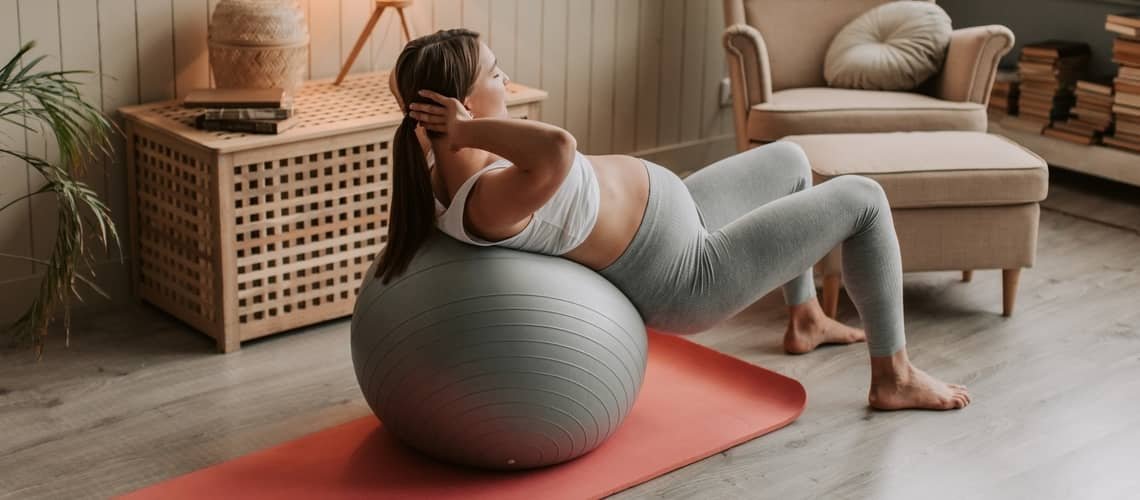
Exercise for pregnant women. The best exercises in pregnancy and what exercises not to do
Not only every mother-to-be, but also every woman is different - it concerns not only appearance, lifestyle, but also the course of pregnancy. Some mothers-to-be suffer from loss of appetite, pain and fatigue, others have only mild symptoms and feel completely fine. Every pregnancy is full of psychological and physical changes, hormones are raging in the woman's body. Exercise is the way to get rid of back, buttock and leg pain and stay in good shape until delivery. In addition, thanks to exercise during pregnancy, you can strengthen your whole body.
- Exercise throughout pregnancy
- Squats in pregnancy
- Kegel exercises in pregnancy
- Yoga for pregnant women
- Pilates for pregnant women
- Fitness during pregnancy
- Exercises for the spine and legs for pregnant women
- Prohibited exercises during pregnancy – cycling, tennis and horse riding
- Exercises for every day during pregnancy
- Exercise during pregnancy - experience
- The most frequent questions - FAQ
- Comments
As long as the pregnancy has a normal course, playing sports is desirable, of course, you must observe a reasonable measure and not overdo it. Not all exercises and activities are allowed during pregnancy. When to start exercising? Is exercise appropriate during all trimesters? Which exercises are best and which to avoid during pregnancy?
Exercise throughout pregnancy
Exercise in the 1st trimester, 2nd and 3rd? Yes, exercise is suitable throughout pregnancy, but only if it is normal and is not accompanied by any health complications. You need to relax and listen to your body, just like the course of pregnancy and exercise during it is an individual matter. Treat exercise as fun, no heroics required. You can exercise 2-3 times a week for 30 to 60 minutes, 15 to 30 minutes is enough for beginners.
Exercises for pregnant women - 1st trimester
Since the period of the 1st trimester is the most critical for the development of the fetus, the frequency and type of exercise should be especially considered. Consideration should also be given to what the symptoms of pregnancy are. The first trimester for most expectant mothers is accompanied by fatigue and frequent nausea, so they don't even think about exercising.
If your health allows it, you can treat yourself to yoga, pilates or exercise on the fitness ball. Kegel exercises, walking and swimming are also recommended. Exercises for the lower abdomen are suitable.
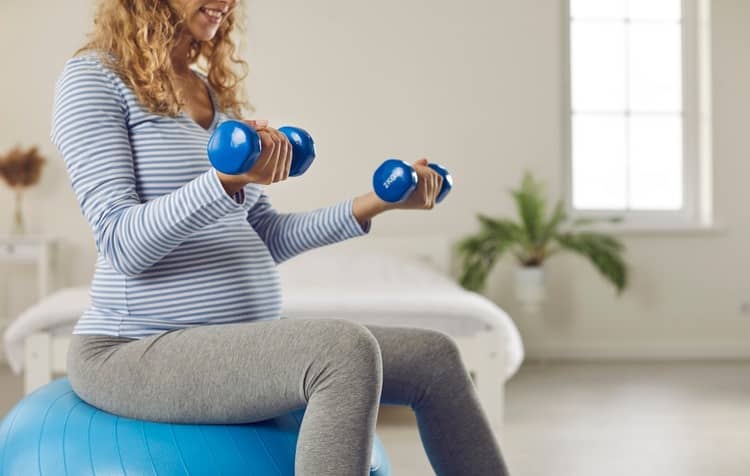
Exercises for pregnant women - 2nd trimester
This is the most comfortable period of pregnancy, as the morning sickness is over, the belly is not yet too big to restrict you. It is the most ideal period for exercise. All of the mentioned exercises are still suitable, but in the 2nd trimester, the rectus abdominis muscle must not be strengthened, only the oblique muscles.
Exercises for pregnant women - 3rd trimester
In this period, it is especially important not to switch your forces. Exercise should bring you relief, you should stretch your tired muscles and get in a good mood. Exercising on a fitness ball, yoga for pregnant women and pilates are still suitable. It is important to exercise the abdominal muscles using breathing exercises and the muscles of the pelvic floor.
Squats in pregnancy
Squats are gentle on the body and are suitable for strengthening the pelvic floor. However, instead of classic squats, use a fit ball for exercise. Stand with your back to a wall and place a ball between the wall and your butt. Let the ball roll up your spine as you exercise. Thanks to the ball, you will do the exercises in an upright position and will not put pressure on your stomach. If you feel up to it, you can also do classic squats while holding a fitness ball in front of you.
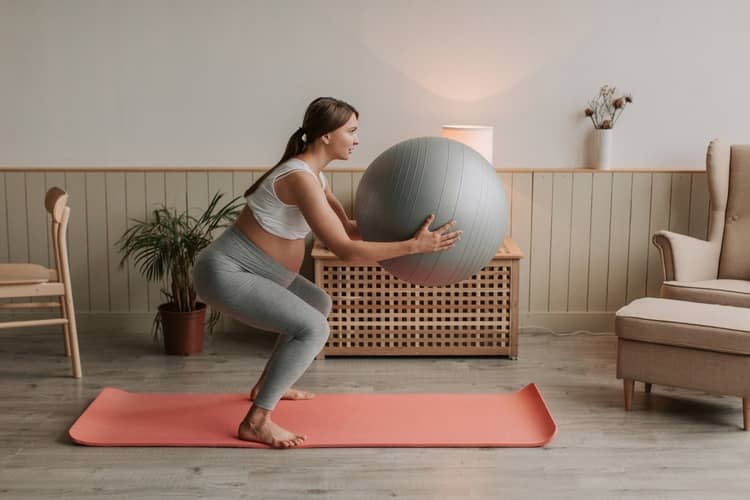
Kegel exercises in pregnancy
This is an ideal exercise for strengthening the pelvic floor. They consist of contracting and relaxing the vaginal muscles, the exercises should last at least 10 seconds, it is advisable to do 10-20 repetitions 3 times a day.
Yoga for pregnant women
Pregnancy yoga or pregnant yoga is one of the most popular exercises for pregnant women. You will exercise your whole body with it and at the same time bring peace to your soul. Gravid yoga is specially designed for women during pregnancy, it is safe and beneficial for both mother and child. It is a series of slow exercises that affect the health of the whole body - it leads to better oxygenation and blood circulation in the body, development of flexibility and muscle strength, helps with back pain, reduces leg swelling and improves posture.
Pilates for pregnant women
Pilates will also help you maintain physical and mental balance. It strengthens the limbs and back muscles, reduces swelling, increases lung capacity and prevents back pain. If you practiced Pilates before pregnancy, it is advisable to continue the exercise in the 1st trimester, otherwise you should only start it in the 2nd trimester.
Fitness during pregnancy
Light dumbbells are a suitable choice for strengthening the arms and upper body. Strong hands will then make it easier for you to carry the baby. The baby already weighs several kilograms after birth, and every week its weight will increase, so you will appreciate strong hands. However, avoid classic strengthening, it is not advisable to lift heavy weights during pregnancy.
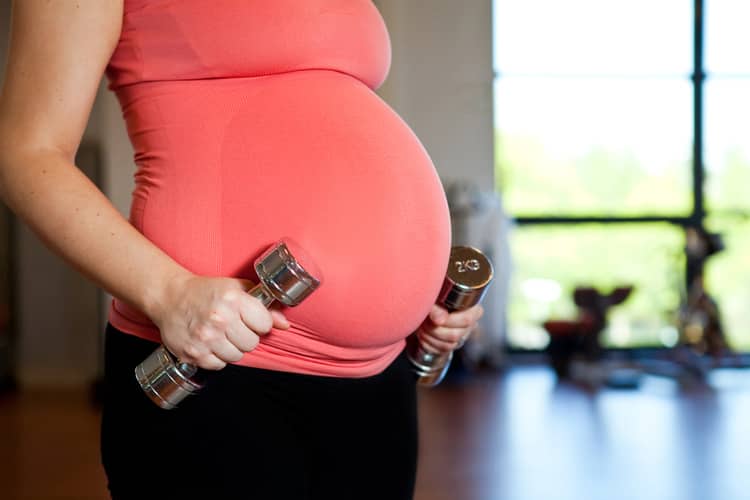
Exercises for the spine and legs for pregnant women
Yoga and Pilates are ideal for exercising the spine and legs. Daily walking is also suitable. You can strengthen your back and the whole body with the plank, of course, if you already have experience with it. If not, proceed with caution and adjust the exercise if necessary, e.g. you can lean your elbows on an elevated place (you are in an inclined position), your feet are on the ground and your body is in one straight line. You can also strengthen your back muscles on a fitness ball.
Prohibited exercises during pregnancy – cycling, tennis and horse riding
During pregnancy, all exercises that risk falling are inappropriate. Avoid riding horses, skiing (even water skiing) and snowboarding, skating and extreme sports (skateboarding or paragliding). Sports that are potentially dangerous can be adapted or made easier. These include weight training, cycling, tennis and ball games. Do not under any circumstances push yourself and do not exercise until exhaustion. Monitor your heart rate during exercise, it should not rise by more than 60% during exercise - it should not exceed 120 beats per minute.
Exercises for every day during pregnancy
It is a simple set of yoga exercises that will help you with back, buttock and leg pain. You can arrange the exercises as you like and practice them as a series every day. Try to breathe in a concentrated manner - inhale through the nose (into the lower part of the chest) and exhale through the mouth.
Position of the child
This is a position in which you stretch your back and relieve back pain (lumbar part of the back, lower back and pelvis). Kneel on your knees, spread them further apart to give space to your belly, with your toes close together. Sit on your heels, stretch your arms forward and put your head on the ground. Stay in the position for 10 breaths.
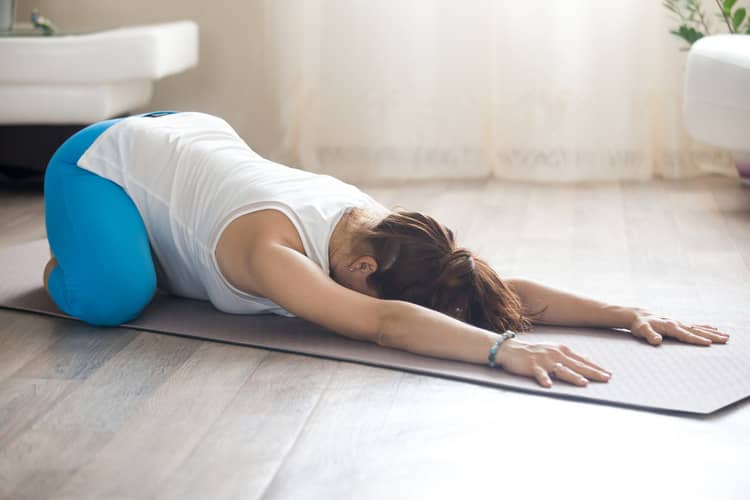
Roof
From the child's position, go to the roof position. Get on all fours, lift your butt and pull your heels to the ground. This will stretch your calves, thighs, buttocks and back. Try to get your chest closer to your knees (it must be comfortable for you). Stay in the position longer than 3 breaths with exhalations. From the position, return to four.
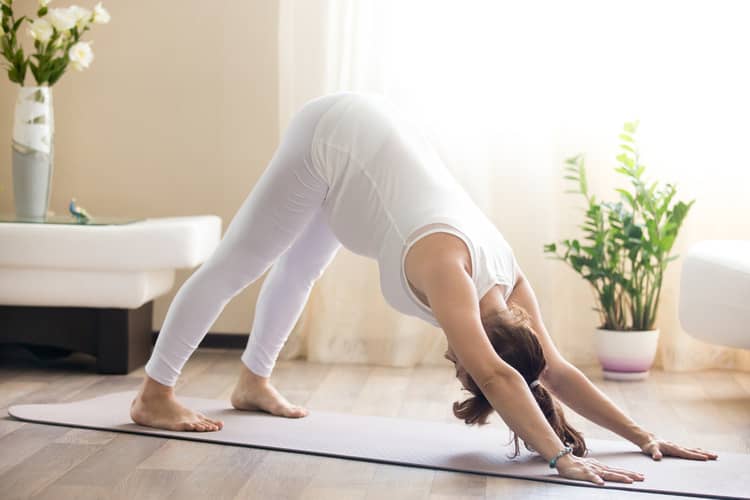
Eagle
Sit on your heels (if you have experience with yoga, you can have your legs in the position as in the picture) and cross your arms - the right goes over the left, they are intertwined. Straighten your back and inhale, while exhaling round your back and pull your elbows to your body. Repeat the exercise 3 times, then switch hands and repeat it 3 times. In the eagle position, exercise your back, especially the trapezius. Get on all fours.
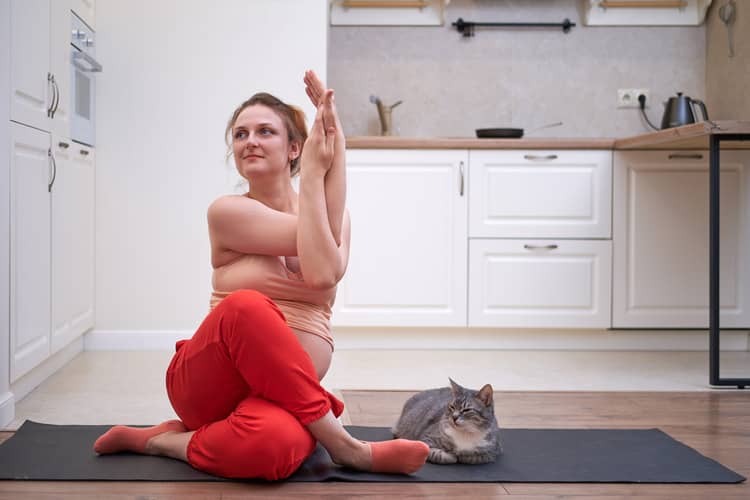
Pigeon
Bring your right knee forward so it's wider than your right hip, bringing your right foot up to the left to feel the stretch on the right buttock. The left leg should be stretched as far back as possible. During the exercise, lean into your hands, your back must be active. Rock the pelvis slightly to the right and left, the butt should be completely relaxed. Stay in the position for 10 breaths, then switch sides.
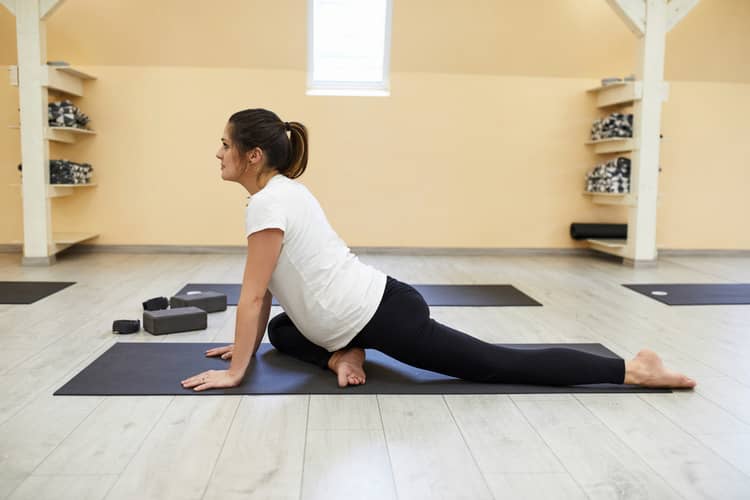
bridge
Go to a lying position, bend both knees and place your hands next to you. Keep your feet firmly on the ground at shoulder width, heels should be below your knees. Raise your pelvis, intertwine your hands under your back, your palms should be between your buttocks and knees (if you don't feel like it, you can have your arms stretched out next to your body). In the bridge position, you stretch your neck and spine and have a positive effect on digestion.
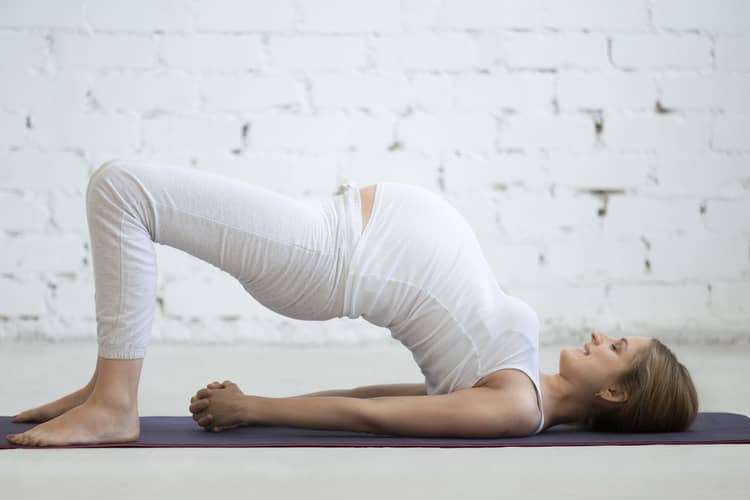
Neck
Then get into the Turkish sitting position (or sit on your heels) and start stretching the cervical spine. While sitting, grab your head with your right hand and gently press it to your shoulder and then point it towards the ground, stretch your other hand away from you (or grab your stomach with it, or put it on your knee, there are more variations). Hold the position for 5 breaths and then repeat on the other side.

A fighter
It is advisable to include the position of warrior 2 in the set. Stand with your feet hip-width apart and step back with your right (a big step) and place it perpendicular to your left. Both feet should be flat on the ground. the front knee should be directly over the heel and the arms should be extended to the sides. With the front leg, make 10 small pulses with exhalation. Then switch legs.
During pregnancy, the warrior position 3 is also suitable. In an upright position, spread your arms to the sides and with an inhale lift your right knee, with an exhale send your leg back, lean forward with your torso and form a line. Repeat the exercise 8 times on each leg.
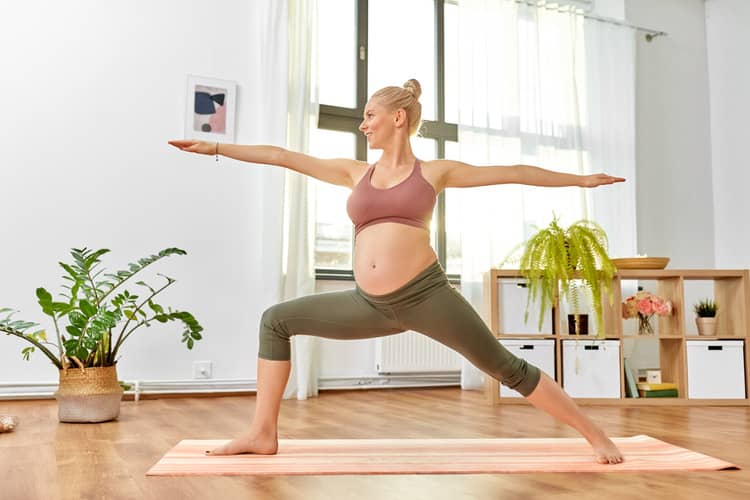
Squats with extensions
Put your feet hip-width apart, they can be wider if you have a bigger stomach. The feet should be firmly on the ground. Lower your butt with an inhale, and with an exhale return to a standing position and lift your heels off the ground. The exercise should be done through the legs, repeat it 10 times.
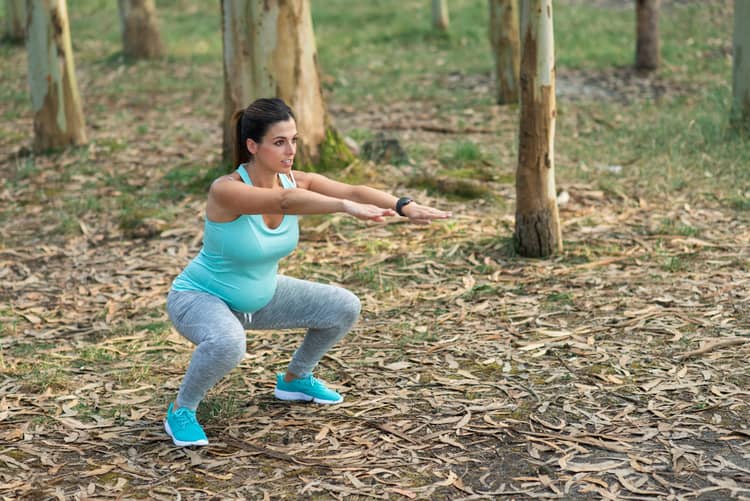
Table
An exercise table is also suitable for pregnant women, which will strengthen your legs, buttocks and back, and open your chest and shoulders. Sit on your butt, touch the ground with your palms and feet. With an inhale, lift the butt off the ground, the pelvis should be in line with the knees and shoulders, with an exhalation, place the butt on the ground. Repeat the exercise 10 times.
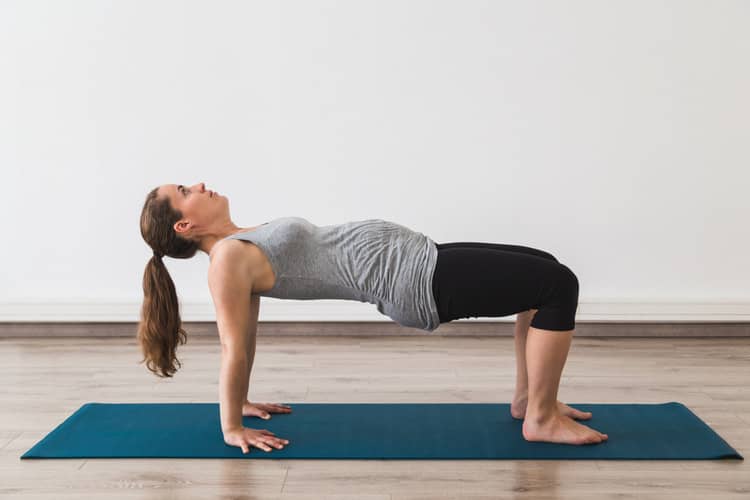
Back lunges
Back lunges are excellent for strengthening the legs. Stand hip-width apart and take a big step back with your right foot on an inhale, and return to the starting position with an exhale. You should feel the weight on the back leg, not on the knees, so as not to strain them. Repeat the exercise 8 times on each leg.
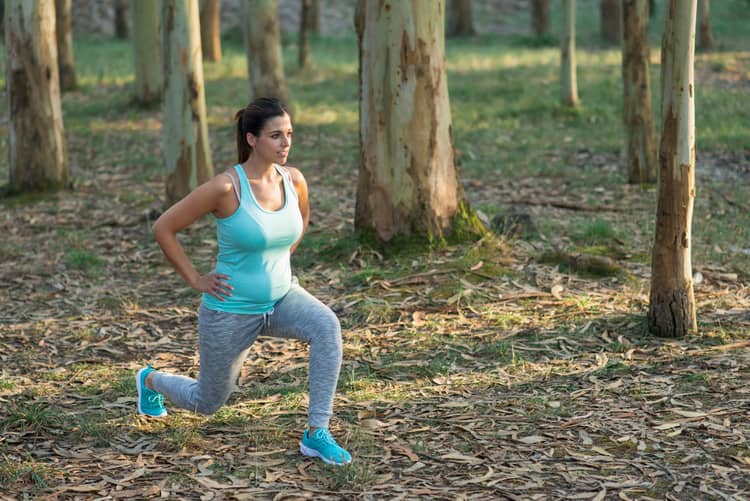
Movement every day
In addition to light yoga, include walking and swimming (if you have access to a pool) in your daily schedule. All exercises are suitable for exercising the body, but they will not burden you too much.
Exercise during pregnancy - experience
In discussions (e.g. Modrykonik) and forums, mothers definitely recommend exercise during pregnancy. They recommend walking, pregnant yoga or cycling on a stationary bike (there is no risk of falling). Relaxation exercises help with back pain and help strengthen the body. Like doctors, moms don't recommend exercise that requires shaking, such as running. It is advisable not to stop exercising if you have been exercising before pregnancy, if not, you should start slowly and with simple exercises. Pregnancy is not a disease and exercise/movement will definitely benefit the expectant mother, just don't overdo it.
The most frequent questions - FAQ
When to exercise during pregnancy? Are kegel exercises and squats suitable during pregnancy? Can I cycle during pregnancy? We believe that we have answered all the essential information regarding exercise during pregnancy. If there's anything else you're interested in, ask in the comments. We will reply as soon as possible.
When can I start pregnant yoga and how long is it appropriate to continue exercising?
Can I do sit-up exercises during pregnancy?
Will I hurt the baby by exercising?
Pridať komentár





